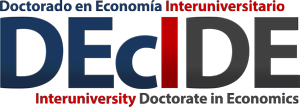- Referencia: García-Martínez, J.A., Meca, A. y Vergara, A.: “Cooperative Purchasing with General Discount: A Game Theoretical Approach”. 2022, Mathematics, 10, 4195: 1-20.
Abstract In some situations, sellers of certain commodities usually provide price discounts for large orders according to a decreasing unit price function. Buyers of such commodities can cooperate and form purchasing groups to benefit from these price discounts. A natural way to allocate the corresponding cost reductions is the equal price rule. We analyze this…
- Referencia: López-Pérez, R., Rodríguez-Moral, A. y Vorsatz, M.: “Simplified mental representations as a cause of overprecision”. 2021, Journal of Behavioral and Experimental Economics, 92, 101681: 1-12.
Abstract Although no consensus on the issue exists yet, some evidence indicates that people are typically overprecise in their inferences. In particular, subjective confidence intervals are often too narrow when compared with Bayesian ones. This paper uses a quasi-Bayesian theory and lab experiments to explore overprecision when people learn about the empirical frequency θ of…
- Fecha(s): 07/03/2024
- Lugar: Sala de seminarios de Economía aplicada (Facultad de Economía y Empresa) - Universidad de Murcia
- Ponente: Adelaida Lillo (Universidad de Alicante)

The aim of this paper is to deepen the analysis of services reshoring in the Spanish services sector, both as a whole and for its constituent elements, examining both intra- and inter-sectoral components. Likewise, it analyzes the impact of this strategy on employment in the services sector, also differentiating between broad reshoring, intra-sectoral reshoring and…
- Referencia: Albaladejo, I.P., Brida, J.G., González-Martínez, M.I. y Segarra, V.: “A new look to the tourism and economic growth nexus: A clustering and panel causality analysis”. 2023, The World Economy, 46: 2835-2856.
Abstract This paper explores the dynamic relationship between tourism and economic growth using panel data for 144 countries over the period 1995–2019. The study was carried out in two steps. First, the set of countries was classified by considering simultaneously two criteria, tourism and the economic development of the countries over time. Two classifications of…
- Referencia: Albaladejo, I.P., Arnaldos, F. y Martínez-García, M.P.: “Tourism distribution at competing destinations: Mobility changes and relocation”. 2022, Tourism Economics, 0(0): 1-23.
Abstract We present a dynamic model of competing destinations to study the agglomeration and dispersion forces driving long-run geographical distribution of tourism. The relative strength of these forces determines whether tourism is agglomerated at one destination or is more disperse. Economies of scale in the tourism industry favour agglomeration while tourists’ preference for local tourist…
- Referencia: Mirete-Ferrer, P.M., García-García. A., Baixauli-Soler, J.S. y Prats, M.A.: “A Review on Machine Learning for Asset Management”. 2022, Risks, 10(84): 1-46.
Abstract: This paper provides a review on machine learning methods applied to the asset management discipline. Firstly, we describe the theoretical background of both machine learning and finance that will be needed to understand the reviewed methods. Next, the main datasets and sources of data are exposed to help researchers decide which are the best…
- Referencia: y Ramallo, S.: “A dynamic factor model to predict homicides with firearm in the United States”. 2023, Journal of Criminal Justice, 86.
Abstract Purpose: Research on temporal dynamics of crime in the United States is growing. Yet, mathematical tools to reliably predict homicides with firearm are still lacking, due to delays in the release of official data lagging up to almost two years. This study takes a critical step in this direction by establishing a reliable statistical…
- Referencia: Quesada, J.A., Méndez, I. y Martín-Gil, R.: “The economic benefits of increasing breastfeeding rates in Spain”. 2020, International Breastfeeding Journal, 15(34): 1-7..
Abstract Background: Interventions aimed at promoting breastfeeding rates are among the most effective possible health policies available, with an estimated return of US$35 per dollar invested. Indeed, some authors found that a 10% increase in exclusive breastfeeding rates in the first two years of life led to a reduction in treatment costs of US$312 million…
- Referencia: Ruiz-Marín, M., Maté-Sánchez-Val, M. y Noguera-Venero, J.: “Did COVID-19 modify the spatial concentration of business failure?”. 2023, Regional Statistics, 13(2): 201-213.
Abstract The existing literature has examined the impact of the coronavirus disease (Covid-19) pandemic on business failure, highlighting firms’ internal characteristics. However, information on changes in firms’ external environments remains scarce. This study examines whether Covid-19 has also influenced the spatial co-locational patterns of business failure processes. Therefore, the authors apply symbolisation techniques to identify…
- Referencia: Beyaert, A., García-Solanes, J. y López-Gómez, L.: “Corruption, quality of institutions and growth”. 2023, Applied Economic Analysis, 31(91), 55-72.
Purpose – This paper aims to apply regression-tree analysis to capture the nonlinear effects of corruption on economic growth. Using data of 103 countries for the period 1996–2017, the authors endogenously detect two distinct areas in corruption quality in which the members share the same model of economic growth. Design/methodology/approach – The authors apply regression…


